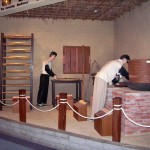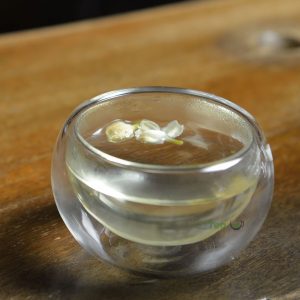Romanization of Names

A calligraphic presentation of the Chinese character for tea, pronounced in Mandarin and a few other Chinese spoken languages as ‘cha’, and some others as ‘té’ and ‘thé’. Since the Chinese written language is logogrammatic and not phonogrammic, the same character has taken on sounds vastly different across the great stretch of territory and millenniums of history. The latter one — ‘té’ and ‘thé’ — is the precursor to the English word ( and many other Latin languages ) tea.
Originated in China, tea has the greatest varieties and diversity in that country. Its nature and development also often have to be referred back to the history and reality there. That is why a large proportion of articles in this site involve names and terms which originals are Chinese. The square characters in which the language has been carried are very different from the Roman alphabets. To communicate these names and terms, romanization — to transcribe non-Latin languages into the Roman alphabets — is needed.
The current mainstream approach in which the logogrammatic Chinese characters are romanized is through a “pinyin” system that had been developed through the 1950s and standardized basing on the Mandarin pronunciation. It is presently the ISO standard for Chinese romanization.
Pinyin is not like the previously popular (and out-dated) “Wade-Giles” system, which I think is much easier for the English speaker, though much less accurate and confusing in the long-run.
Rather than having to explain either system in detail in this site, here are some web links in case you need more in depth explanation:
About Pinyin:
- in Wikipedia
- A “Gong” project by the University of Science and Technology, Hong Kong
- Yellow Bridge Chinese English Dictionary
About the Wade-Giles system:
If you prefer not to read the lengthy articles in these links, you can pronounce most romanized Chinese terms as if they were Latin / English. The more obvious challenges would be the z, zh, q and c “consonants”. They are equivalent to “ts”, “ʈʂ”, “tɕʰ”, and “tsʰ” respectively in International Phonetic Alphabets. Too complicated? They are really only different ways to speak the “ts” sound with various emphasis.
For example, the dark tea brick popularly consumed in Tibet, zang cha, can be roughly pronounced as tchang cha. The Phoenix oolong variety Qunti Dancong can be roughly pronounced as tsun-ti dan-tsong, although when you hear the proper pronunciation you will notice some slight differences. However, for the non-Chinese speaking audience, it is better to at least make something out of the terms rather than putting them aside. I’d say that is good enough. Those who are really serious about it and want to pronounce them accurately, some studying is needed. The links above can be a beginning.
In this site, we try as much to follow the pinyin system. However, there are exceptions.
We do not want to confuse the readers with new labels to names that they are likely to be already familiar with. For example, Hong Kong will be Hong Kong and not Xiang-gang, which is the pinyin way of romanization of the city’s name.
For names that are already quite known in the West, such as the word oolong, I will not use the proper pinyin presentation, which is wu’long. In cases where there is already a popular translation of the name, such as Phoenix, I’ll use this rather than the pinyin presentation, Fenghuang, which basically represents the same meaning.
Other popular names that have already been mis-represented with products of other natures, such as Bohea, Congou, and Pekoe, will be referred to but their proper representations re-established in related writings.
Reading words in pinyin is actually a bit awkward only in the beginning, but since there is a good logic in the structure, it becomes quite natural once you have tried a few.
As for Japanese, the other language with names that are romanized in this site, the more popular romaji presentation is employed, as in the Hepburn system, but without the macrons in the general text, for ease of reading. The alphabets in this system basically follow the English phonologic habits so one basically read the words as English. It is not accurate, according to my Japanese friends, but it has the advantage of cognitive efficiency, and most writings for popular reading follow this same convention. For more information, these are some useful links:
http://judopedia.com/index.php?title=Hepburn_romanization
http://www.translitteration.com/transliteration/en/japanese/iso-3602-kunrei-shiki/
Using this approach will inevitably result in writings with a cocktail of phonetics, involving also the complication of long-established tea terms transliterated from old Chinese coastal dialects. I am not sure if this approach will alienate more or communicate better, but I am hoping for the latter, so let’s give it a try. Please do post your feedback in case you have comments or ideas.










